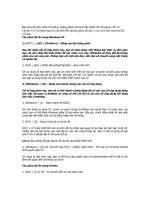Tài liệu tiếng Anh (cao học) Chapter 4 A portfolio of relationships
Bạn đang xem bản rút gọn của tài liệu. Xem và tải ngay bản đầy đủ của tài liệu tại đây (564.85 KB, 45 trang )
Chapter 4
A Portfolio of
Relationships
4-1
Key Concepts
•
A Transformation in Relationships
•
Types of Buyer-Supplier Relationships
»
Transactional Relationships
»
Collaborative and Alliance Relationships
»
Collaborative Relationships
»
Supply Alliances
•
The Supplier's Perspective
•
Developing and Managing Collaborative
and Alliance Relationships
4-2
Key Concepts
•
Situations Wherein Alliances may not be
Appropriate
•
The Role of Power
•
A Portfolio Approach
•
New Skills and Attitudes Required
•
E-Commerce and the “Right” Type of
Relationship
•
Relationships of the Future
4-3
A Transformation in Relationships
•
The transformation from reactive and
mechanical purchasing to proactive
procurement and on to strategic Supply
Chain Management parallels a similar
transformation in relationships between
buyers and suppliers
•
Prior to the 1980s most purchasing
relationships were reactive
•
Interaction between vendor and
purchasing resulted in outcomes where
one’s gain would be the other’s loss
4-4
Problems with the Term “Partner”
•
During the late 1980’s and early 1990’s,
“partnerships” became popular
»
Implications of the term “partner” were not
well understood
»
Legal problems and concerns inevitably arose
•
While the term “partnership” is still
relatively common, we avoid use of the
term preferring the terms “collaborative
relationship” and “strategic alliance.”
4-5
Three Types of Buyer Supplier Relationships
•
Transactional
•
Collaborative
•
Alliance
4-6
Continuum of Buyer-Seller Relationships
Figure 4-1
Figure 4-1
Communication
Competitive Adv.
Connectedness
Continuous Impr.
Contributions to NPD
Difficulty of Exit
Duration
Expediting
Focus
Level of Integration
High pot. for problems Systematic approach
Low High
Independence Interdependence
Little A focus
Few Many – ESI
Low Difficult – high impact
Short Long
Reactive Proactive
Price Total cost
Little or none High or total
Activity/Attribute Transactional Collaborative Alliance
4-7
Continuum of Buyer-Seller Relationships
Number of Suppliers
Open Books
Quality
Relations
Resources
Service
Shared Forecasts
Supply Disruptions
Technology Inflows
Type of Interaction
Many One or few
No Yes
Incoming inspection Design quality in system
Inward looking Concern w/well being
Few – low skill level Professional
Minimal Greatly improved
No Yes
Possible Unlikely
No Yes
Tactical Strategic synergy
Activity/Attribute Transactional Collaborative Alliance
Figure 5-1 Continued
Figure 5-1 Continued
4-8
Transactional Relationships Characteristics
•
An absence of concern
•
One of a series of independent deals
•
Costs, data and forecasts are not shared
•
Price is the focus of the relationship
•
A minimum of purchasing time and energy
is required to establish prices
•
Transactional purchases lend themselves
to e-procurement
4-9
Advantages of Transactional Relationships
•
Relatively less purchasing time and effort
are required to establish price
•
Lower skill levels of procurement
personnel are required
4-10
Disadvantages of Transactional Relationships
•
Potential for communication difficulties
•
Expediting and monitoring of incoming quality
•
Inflexible when flexibility may be required
•
Tend to result in more delivery problems
•
Quality will be only as good as required
•
Suppliers provide the minimum service required
•
Less effective performance by suppliers
•
Customers are subject to more supply
disruptions
•
Supplier is not motivated to invest time and
energy development of buyer’s products
4-11
Collaborative and Alliance Relationships
•
“76% of CEO’s think external collaboration
with business partners and customers is
key to innovation”
•
Collaborative and alliance relationships
tend to result in lower total costs and
improve performance of the supply chain
4-12
Three Success Factors
•
Researchers Stanley and Pearson found
that the three most important factors in a
successful buyer-supplier relationship
are:
»
(1) two-way communication,
»
(2) the supplier's responsiveness to supply
management's needs, and
»
(3) clear product specifications
4-13
Collaborative Relationships
•
Typically used for the procurement of non-
commodity items and services
•
A collaborative relationship frequently is
an appropriate first step on the road to a
strategic alliance
4-14
Collaborative Relationships
•
Collaborative relationships tend to
foster….
»
Longer term contracts
»
Reduction of risk for suppliers
»
Reducing total costs
»
Improvement of processes
»
Improvement of products
»
Increased investment in R & D
»
Increased investment in training
»
Increased investment in equipment
»
Better focus on customer needs
4-15
Supply Alliances
•
The fundamental difference between
collaborative relationships and supply
alliances is the presence of institutional
trust in alliances
•
The failure to develop and manage
institutional trust is the principle reason
that so many supply alliances fail
4-16
Benefits of Supply Alliances
•
Lower total costs.
•
Reduced time to market
•
Improved quality
•
Improved technology flow from suppliers
•
Improved continuity of supply
4-17
Alliance Attributes
•
Continuous improvement
•
Interdependence and commitment.
•
Atmosphere of cooperation
•
Informal interpersonal connections
•
Internal infrastructures to enhance
learning
•
Openness in all areas of the relationship
•
A living system
4-18
Alliance Attributes Continued
•
A shared vision of the future
•
Ethics take precedence over expediency
•
Adaptable in the face of change
•
Design of experiments and supplier
certification
•
Win-Win negotiations
•
Executive level commitment
•
Avoid terms that could prove destructive
4-19
Which Relationship is Appropriate?
•
What are the “Strategic Elements of a Relationship?”
•
Are there many relatively undifferentiated suppliers
providing what amounts to inter-changeable
commodities?
•
Does the potential supplier possess economic power
which it is willing to employ over its customers?
•
If there is recognition by both parties of the potential
benefits of an alliance, but adequate qualified human
resources are not available at one or both firms?
4-20
Strategic Elements of a Relationship
•
Is one supplier head and shoulders above the
rest in terms of the value it provides; including
price, innovation, ability to adapt to changing
situations, capacity to work with your team, task
joint risks, etc?
•
Are some suppliers “strategic” to your business?
•
Would your company benefit greatly if the
supplier were more “integrally connected” with
your company?
•
Do your customers require high degrees of
flexibility and speed of responsiveness?
4-21
The Supplier’s Perspective
•
Supplier’s want good customers
•
Several issues affect their assessment,
among them are:
»
Cash Flow
»
Openness and Approachability
»
Availability
»
Professionalism
4-22
Questions to be Addressed Before Proceeding
•
Is there a danger that the supplier may act in an
opportunistic manner over time?
•
Do electronic systems allow for optimum
communication and sharing of information?
•
Is the potential strategic alliance able to stay
current in the industry?
•
Are both the organizations willing to keep
attention focused on the joint customer?
•
Are there other suppliers worth investigating
before committing to a strategic alliance?
•
Has the supply manager been thoroughly
trained?
4-23
Questions to be Addressed Before Proceeding
•
Is the organization proud to be aligned and
associated with the supplier?
•
Is the organization comfortable with the level of
risk associated with reducing the supply base?
•
Are both supplier and buyer aligned in what their
ultimate customer considers to be valuable?
•
If there is substantial risk for the supplier to
develop new technologies, products, processes,
or service support?
•
Are both supplier and buyer aligned in their
respective visions?
•
Are there sufficient operational points of
interaction?
4-24
Situations Wherein Alliances may not be
Appropriate
•
Stability
»
Price Volatility
»
Demand Volatility
»
High Switching Likelihood with High Switching Costs
•
Capability
»
No Partnership/Alliance-Capable Supplier for the Item
»
No Partnership/Alliance-Capable Supplier in the
Geographic Area
»
Rapid Technological Change
»
Mismatch of Clock Speed
4-25









